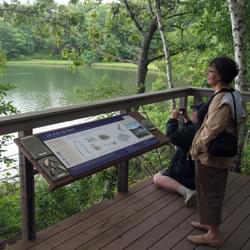




Planning Trails with Wildlife in Mind
Offering wildlife interpretation and environmental education to trail users can play an important role in reducing impacts to wildlife. People more readily protect what they understand and appreciate.

While the specific activities associated with managing a trail come after it has been built, an understanding of how a trail will be managed must be part of planning the trail. Management is a poor substitute for a lack of planning.
Trail management is more effective when it is planned up front, rather than later as a corrective for poor trail location. Because environmental conditions change along the length of a trail, it is often useful to identify distinct zones along the trail, where management reflects differences in wildlife habitat and recreation use.
Adaptive management— in which the process of managing a trail can be used to learn more about impacts to wildlife— is especially appropriate for trails given the uncertainties of potential wildlife impacts.
The best laid trail plans, carefully crafted and built with wildlife in mind, can be disrupted by people who choose to make trails of their own. Social trails are one of the biggest challenges facing trails planners and managers, who may have worked long hours to provide trails that respect wildlife. Social trails degrade vegetation and may increase soil erosion.
Carefully monitor the trail corridor to detect social trails early. Then use brush, boulders, signs, or other means to dissuade use.
Monitoring and other aspects of effective trail management may seem like luxuries, but they are actually basic stewardship requirements. Finding the resources to accomplish this stewardship will require the same levels of creative effort as building the trail.
Volunteers can be tremendously helpful in managing trails. They can serve as trailhead hosts or trail guides who offer information about wildlife and trail regulations. They can conduct interpretative programs and help with trash pickup and other maintenance tasks. Volunteers can enforce rules and educate trail users about seasonal wildlife closures, inventory and monitor wildlife, and much more.
Trails present good opportunities for the public to understand wildlife. Whether conducted by volunteers or paid staff, offering wildlife interpretation and environmental education to trail users can play an important role in reducing impacts to wildlife. People more readily protect what they understand and appreciate. Interpretive programs, guided tours, staff interactions, signs, brochures, maps, and videos can all be effective in communicating appropriate visitor behavior among wildlife.
Sound regulations are needed to protect wildlife, but they also need to be enforced.
J.1 Early management planning.
Plan how to manage a trail’s wildlife issues before its alignment is set.
J.2 Resolving conflicts.
Don’t depend on management to resolve wildlife conflicts that can be avoided by careful alignment in the first place.
J.3 Increased demands on management.
More careful management of resources will be required when a trail passes through or near sensitive habitat.
J.4 Predictability.
Wildlife accept the more predictable disturbances of people (and dogs) on trails more readily than off trails.
J.5 Weed-free feed.
Using weed-free feed for packstock will help minimize weed invasions.
J.6 Discouraging generalists.
Encourage visitors not to leave food or garbage around to further support generalists species.
J.7 Multiple approaches.
Use a combination of management techniques to facilitate the coexistence of recreationists and wildlife.
J.8 Volunteers. Enlist the help of trail users in monitoring wildlife use of the trail corridor and other activities.
J.9 General references. To protect wildlife, when describing points of sensitive, ecological interest near a trail— sites you want people to know about, but not visit— don’t indicate the direction or distance to the spot.
J.10 User facilities. Provide facilities, such as blinds, viewing areas, and boardwalks, for visitors to see wildlife with minimal disturbance.
J.11 Interpretation.
Interpretation and environmental education are very important management tools. If people value wildlife and understand the implications of their own actions, they are less likely to behave in ways that are harmful to wildlife.
[Older publications may be available from libraries and used booksellers. Titles with links may still be in print.]
Larson, R., “Balancing Wildlife Viewing with Wildlife Impacts: A Case Study,” in Knight, R. and K. Gutzwiller, eds., 1995. Wildlife and Recreationists: Coexistence through Management and Research. Island Press, Washington, D.C., pp. 51-69.
“Agencies and Volunteers: Conducting Your Own Volunteer Projects,” Volunteer for Outdoor Colorado, 1990. To order: Volunteers for Outdoor Colorado, 600 South Marion Parkway, Denver, CO 80209, (303) 715-1010.
“Organizing Outdoor Volunteers, Second Edition,” Appalachian Mountain Club Books, 1992. To order: Appalachian Mountain Club Books, P.O. Box 298, Graham, NH 03581, (800) 262-4455.
Sustaining Wildlife With Recreation on Public Lands
posted Nov 25, 2023
Humans and wildlife interact in multifaceted ways on public lands with both positive and negative outcomes for each group. When managed well, wildlife-based tourism and other forms of recreation can benefit conservation goals.
Environmental Impacts of Winter Recreation
posted Nov 25, 2023
Regardless of our intentions, many species perceive humans as a threat and respond accordingly. In general, animals respond to threats by first increasing vigilance (time spent looking around versus foraging), and running away if the threat is perceived to be imminent.
posted Nov 24, 2023
Winter recreation is a rapidly growing activity, and advances in technology make it possible for increasing numbers of people to access remote backcountry terrain. Increased winter recreation may lead to more frequent conflict between recreationists, as well as greater potential disturbance to wildlife.
Guidelines for Managing and Restoring Natural Plant Communities along Trails and Waterways
posted Sep 18, 2023
These guidelines are designed to assist resource managers in conducting management activities that enhance the quality of natural plant communities, wildlife habitat, regional landscape integrity and visual quality, particularly as related to planning, development, and maintenance of trails, water trails, and water access sites.
1,126 views • posted 09/08/2018